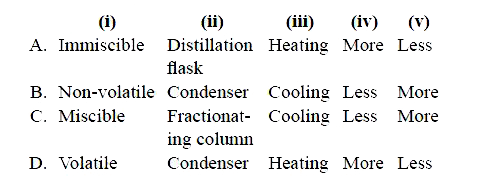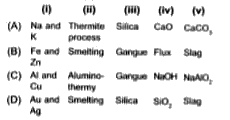Fill in the blanks by choosing an appropriate option.
W ––––––––– is a very reactive metal, reacts vigorously with oxygen and water therefore, stored in (1) ––––––––––.
X ––––––––– is a non-metal, soft and dull and forms (2) –––––––––– oxides with oxygen.
Y ––––––– is very reactive (3) –––––––––––, catches fire if exposed to air therefore, stored in water.
Z –––––––– does not react with dilute hydrochloric acid even on heating but it reacts with sulphuric acid. When it is exposed to moist air for long, it acquires a dull (4) –––––––– coating.
W-Na, 1-Water, X-S, 2-Basic, Y-P, 3-Metal, Z-Cu, 4-Reddish brown
W-Mg, 1-Kerosene, X-P, 2-Acidic, Y-Si, 3-Metal, Z-Ag, 4-Reddish brown
W-Na, 1-Kerosene, X-S, 2-Acidic, Y-P, 3-Non-metal, Z-Cu, 4-Green
W-Al, 1-Water, X-Zn, 2-Amphoteric, Y-P, 3-Non-metal, Z-Cu, 4-Green
The correct Answer is:C
To fill in the blanks for the given question, we can analyze each part of the statement step by step.
Step 1: Identify W
- Statement: ul(" W ") is a very reactive metal, reacts vigorously with oxygen and water therefore, stored in (1) ––––––––––.
- Analysis: The metal that is very reactive and reacts vigorously with oxygen and water is sodium (Na). Sodium is an alkali metal known for its high reactivity.
- Conclusion: W = Sodium
- Storage: Sodium is stored in kerosene to prevent it from reacting with moisture and oxygen in the air.
Fill in the blank (1): Kerosene
Step 2: Identify X
- Statement: X ––––––––– is a non-metal, soft and dull and forms (2) –––––––––– oxides with oxygen.
- Analysis: The non-metal that is soft and dull and forms acidic oxides is sulfur (S). Sulfur is known for forming sulfur dioxide (SO2) when it reacts with oxygen.
- Conclusion: X = Sulfur
- Type of oxides: Sulfur forms acidic oxides.
Fill in the blank (2): Acidic
Step 3: Identify Y
- Statement: Y ––––––– is very reactive (3) –––––––––––, catches fire if exposed to air therefore, stored in water.
- Analysis: The non-metal that is very reactive and catches fire when exposed to air is phosphorus (P). Phosphorus is known to ignite spontaneously in air.
- Conclusion: Y = Phosphorus
- Type of reactivity: Phosphorus is very reactive.
Fill in the blank (3): Non-metal
Step 4: Identify Z
- Statement: Z –––––––– does not react with dilute hydrochloric acid even on heating but it reacts with sulphuric acid. When it is exposed to moist air for long, it acquires a dull (4) –––––––– coating.
- Analysis: The metal that does not react with dilute hydrochloric acid but reacts with sulfuric acid is copper (Cu). When copper is exposed to moist air, it forms a greenish coating of copper carbonate or copper oxide.
- Conclusion: Z = Copper
- Coating: The dull coating formed is green.
Fill in the blank (4): Green
Final Answers:
1. Kerosene
2. Acidic
3. Non-metal
4. Green
---
- Statement: ul(" W ") is a very reactive metal, reacts vigorously with oxygen and water therefore, stored in (1) ––––––––––.
- Analysis: The metal that is very reactive and reacts vigorously with oxygen and water is sodium (Na). Sodium is an alkali metal known for its high reactivity.
- Conclusion: W = Sodium
- Storage: Sodium is stored in kerosene to prevent it from reacting with moisture and oxygen in the air.
- Statement: X ––––––––– is a non-metal, soft and dull and forms (2) –––––––––– oxides with oxygen.
- Analysis: The non-metal that is soft and dull and forms acidic oxides is sulfur (S). Sulfur is known for forming sulfur dioxide (SO2) when it reacts with oxygen.
- Conclusion: X = Sulfur
- Type of oxides: Sulfur forms acidic oxides.
- Statement: Y ––––––– is very reactive (3) –––––––––––, catches fire if exposed to air therefore, stored in water.
- Analysis: The non-metal that is very reactive and catches fire when exposed to air is phosphorus (P). Phosphorus is known to ignite spontaneously in air.
- Conclusion: Y = Phosphorus
- Type of reactivity: Phosphorus is very reactive.
- Statement: Z –––––––– does not react with dilute hydrochloric acid even on heating but it reacts with sulphuric acid. When it is exposed to moist air for long, it acquires a dull (4) –––––––– coating.
- Analysis: The metal that does not react with dilute hydrochloric acid but reacts with sulfuric acid is copper (Cu). When copper is exposed to moist air, it forms a greenish coating of copper carbonate or copper oxide.
- Conclusion: Z = Copper
- Coating: The dull coating formed is green.
1. Kerosene
2. Acidic
3. Non-metal
4. Green
Topper's Solved these Questions
- BOOK - SCIENCE OLYMPIAD FOUNDATION CHAPTER - NSO QUESTION PAPER 2016 SET BEXERCISE - ACHIEVERS SECTION1videos
NSO QUESTION PAPER 2016 SET B
- BOOK - SCIENCE OLYMPIAD FOUNDATION CHAPTER - NSO QUESTION PAPER 2016 SET A EXERCISE - ACHIEVERS SECTION1videos
NSO QUESTION PAPER 2016 SET A
- BOOK - SCIENCE OLYMPIAD FOUNDATION CHAPTER - NSO QUESTION PAPER 2017 SET A EXERCISE - ACHIEVERS SECTION1videos
NSO QUESTION PAPER 2017 SET A
Similar Questions
Fill in the blanks.
1 0 0 0 0 0 0− * * * * 1–––––––––––––––– * 7 0 4 2 *–––––––––––––––View SolutionRead the given passage and fill in the blanks by choosing an appropriate option.
When a mixture of two (i) –––––––– liquids having a difference of 25∘C in their boiling points is to be separated, a (ii) –––––––– is used which increases the (iii) ––––––––– surface area. As a result, when the vapours of both the liquids rise, the (iv) –––––––––– volatile liquid will condense while the vapours of (v) –––––––– volatile liquid will rise.
 View Solution
View Solution
Knowledge Check
- Question 1 - Select One
Phosphorus is a very reactive non - metal . To prevent contact of phosphorus with oxygen, they are stored _______.
AairBwaterCsoilDkerosene - Question 2 - Select One
Read the given passage carefully and fill in the blanks by selecting an appropriate option.
Oxides of (i) –––––– are reduced to their respective metals by heating with coke and the process is called (ii) –––––––. Before carrying out reduction with carbon, if the calcined or roasted ore still contains infusible impurities of earthy matter, called (iii) ––––––––, an additional substance, called (iv) –––––––– is added which combines with (iii) to form a fusible material, called (v) –––––––. AABBCCDD
AABBCCDD - Question 3 - Select One
Fill in the blanks with appropriate choice.
Bond ordr of N+2is P–––––while that of N2is Q–––––.
Bond order of O+2is R––––– while that of O2is S–––––.
N - N bond distance T––––– when N2 changes to N+2 and when O2 changes to O+2 , the O - O bond distance U–––––.APQRS T U22.52.51increasesdecreasesBPQRS T U2.5321.5decreasesincreasesCPQRS T U321.51increasesdecreasesDPQRS T U2.532.52increasesdecreases
Fill in the blanks by choosing an appropriate option.
In a (i) –––––– wave the particles of the medium oscillate in a direction (ii) ––––––– to the direction of propagation. Thus, during their oscillations, the particles may move upwards or downwards from the plane passing through their mean positions. The point of maximum positive displacement on a transverse wave is called (iii) –––––––– and the point of maximum negative displacement is called (iv) ––––––––. The wave produced in a stretched string when plucked are (v) ––––––– waves.
 View Solution
View SolutionRead the given passage and fill in the blanks by selecting an appropriate option. Bleaching powder is a (i) –––––– powder. When exposed to air, it reacts with (ii) ––––––– of the air to liberate Cl2 gas. It is (iii) –––––––– in cold water and milkiness of the solution is due to presence of unreacted (iv) ––––––––. It reacts with HCl and H2SO4 liberating (v) ––––––– gas.
 View Solution
View SolutionFill in any four of the following blanks choosing the most appropriate options from the ones given below. Write the answers in your answer sheet against the correct blank numbers.
He will fly 1– Madras 2– 7th December. The plane 3– reach Madras 4– 11.00 am. He 5– stay at Hotel Plaza.View SolutionFill in any four of the following blanks choosing the most appropriate options from the ones given below. Write the answers in your answer sheet against the correct blank numbers.
He will fly 1– Madras 2– 7th December. The plane 3– reach Madras 4– 11.00 am. He 5– stay at Hotel Plaza.View SolutionFill in any four of the following blanks choosing the most appropriate options from the ones given below. Write the answers in your answer sheet against the correct blank numbers.
He will fly 1– Madras 2– 7th December. The plane 3– reach Madras 4– 11.00 am. He 5– stay at Hotel Plaza.View Solution

